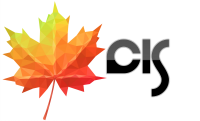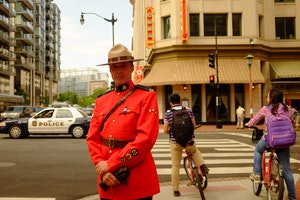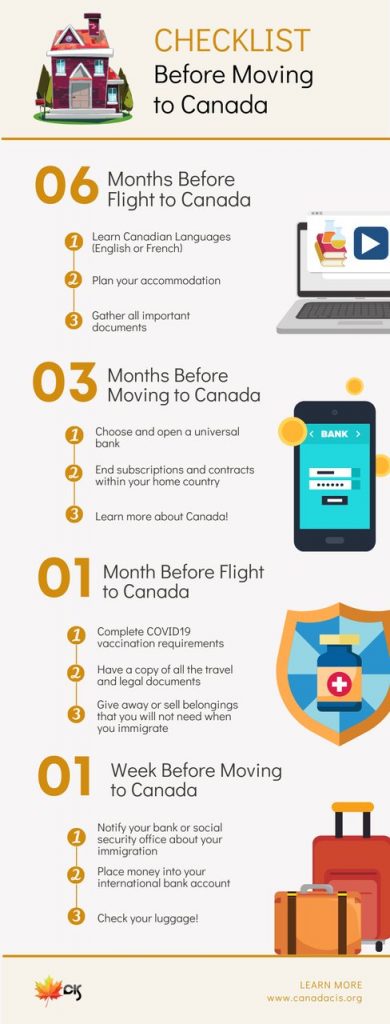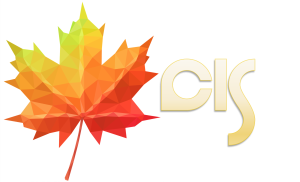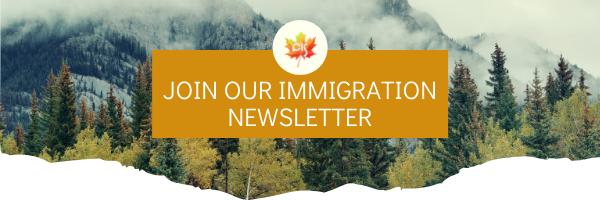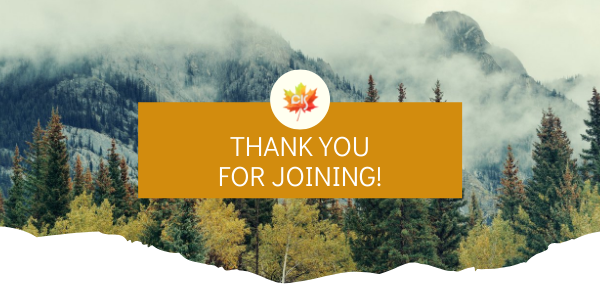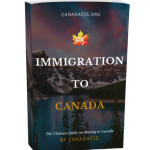21 Things To Do After Arriving in Canada
Home » Blog » Immigration to Canada » What Should You Do After Landing in Canada
Exceptional work! You have successfully navigated all of the obstacles towards your immigration to Canada.
Before you can fully experience life as a Canadian Permanent Resident, you must first have a complete understanding of the process, as well as what you will be required to accomplish once you’ve arrived.
Technically, your tasks won’t be over just yet. Canada is only the first step towards a totally new life; your adventure isn’t over yet.
Want to get ahead of the game and prepare yourself for what to expect upon arrival? We’ve listed 21 things you’ll need to do AFTER moving and how to do it (properly 😉)!
So let’s get straight to the point shall we?
Things to Do After Moving to Canada
1. Activate Your Permanent Residency at the Port of Entry ✅
Obtain the Immigration Officer’s signature and stamp on your Confirmation of Permanent Residency (COPR) upon arrival at the port of entry.
2. Submit an application for a Social Security Number (SIN) 🔢
Once you arrive, you’ll need to apply for a SIN. You can easily do this upon arrival at the airport using your temporary address in Canada.
You may apply to the Service Canada office in your designated province even if you don’t have a Canadian address yet. Walk-ins are available.
3. Get Your PR Card, Your Wallet-Sized Status Card 📇
You’ll need to apply for Canada Permanent Residence card, having this in hand is a convenient proof of permanent residency status. This allows you to comfortably travel within Canada hassle-free if you wish to pass from province to province.
4. Sign-up for a Local Mobile Number 📱
Any country has a broad variety of mobile networks, and Canada is no exception. Every carrier offers distinctive voice, texting, and data packages. Canada’s main telecommunication service providers include ROGERS, TELUS, KOODO, and BELL.
You may purchase a SIM card from a shop near you.
5. Set up a Bank Account 💵
Setting up a bank account is something you’ll need to do once you get here.
If you are in Canada without a PR card, you’ll need a COPR document, a SIN number, and a passport copy to set up a bank account.
You will need to call the bank to arrange a meeting.
Banks like TD, RBC, Scotiabank, CIBC, HSBC, BMO, and others comprise Canada’s best banks to choose from.
6. Register for a Health Card 👩⚕️
Landing in Canada means applying for a health care card, and free medical coverage is available in the province or territory where you will reside. To receive quality healthcare in Canada, it’s definitely a priority for you to receive a health care card the moment you arrive.
7. Apply for Utility Services 💡
You must apply for the utility in question with a current SIN number, your spouse’s or partner’s SIN number, a rental agreement, and COPR papers.
The electrical connection will be then transferred to your name, which is already in the house.
After a one-time charge, your energy use will be covered for the remainder of the month.
8. Register for Child Care Benefit (CCB) 🧒
Canada’s government helps parents with children under 18. This is to provide the children of Canada a better future.
If you are a permanent resident and have children with you once you arrive, it’s important to know that you’re eligible to apply for child care benefits in Canada.
9. Get Familiar with your City or Province + Explore and Have Fun! 🗺️
Not everything you need to do once you arrive has to be boring! One thing you should definitely do is to get familiar with your surroundings. Exploring your city and enjoying the sights is a great way to quickly adjust to your new home country. Relax, walk around the neighborhood, and find the nearest coffee shop to get accustomed to your area.
10. Visit Canadian Settlement Organizations 🤝
You may feel overwhelmed by the difficulty of moving to a new country if you have little understanding of its culture, laws, and customs.
Canada’s settlement organizations assist immigrants adapt to their newfound home. Free services and resources may be found from local settlement organizations, which offer information and assist you in transitioning to Canadian culture. You may get personal assistance with your unique settlement requirements from a settlement counselor in an organization.
11. Apply for Driving License 🚗
In Canada, it is legally required to have a government-issued driver’s license to drive a vehicle. Any valid Canadian driver’s license will allow you to drive anywhere in the country, it’s also a great identification card that you’ll need to bring with you everywhere you go. You can get your license at the nearest license authority operator. Click for more tips on buying your first car in Canada.
12. Get a Public Transit Card 🗂️
It’s always useful to get a transit card. Getting around with your own car might not always be the best idea. By using a bus or city transportation, you may lower your taxi fare and decrease your journey time in places like Toronto, where taking a car to work can be time-consuming. One way to get a local transport card is to apply for one at a local transit office. The transit pass offers unlimited trips per month and may be made for a month with a normal fee or for a set number of journeys at a reduced cost.
13. Look for a Suitable Service Provider, Get Wi-Fi Connection! 🌐
You get little mobile data per month with these mobile data plans, which is barely enough for smartphones. While it’s not entirely critical, I believe it’s essential for people during these times. Especially if you land a work from home job.
The plans from different internet service providers vary. Here are some of the top providers to choose from:
- Bell
- Shaw
- Rogers
- Telus
14. Apply for Provincial Identity Card 📇
As a general rule, ID cards are essential for almost all government activities. In most cases, you will need two forms of identification for anything from signing up for a bank account to purchasing a vehicle to taking a driving test.
Get your ID card first, and then you won’t have to keep digging through your bag for your passport.
15. Enroll Your Children in School or Day Cares 🏫
The primary education system in Canada is entirely free of charge and begins in kindergarten and runs through 12th grade.
Classes begin in September and end in June. The summer vacation is between July and August. If your child attends school, arrange your arrival date accordingly.
It is essential that you register your child’s name on the school list immediately since it may take a long time to get into a daycare, and even more time to get into a school.
Contact your closest settlement agency or newcomer’s information center to get more information about your city’s childcare services.
16. Connect with your Community + Start Volunteering 🧑🤝🧑
Introduce yourself to others in your neighborhood, check Facebook or Google for nearby activities, and sign up for them. Be at ease in chatting to any Canadian since we are amiable, relaxed, and sociable. Joining local Facebook groups and pages may help you find out about events and news in your area. This is a great way to find friends in Canada!
17. Look for the nearby Furniture Bank in Canada, Buy Household and Essentials Items 🏦
You’re moving here and beginning a fresh start. Searching for things around the house? Begin your search at the Canadian furniture bank for free and quality furniture. All you have to do is Locate the nearest ‘Furniture Bank in Canada’ to you and register yourself with them. Once registered, you will need to provide two pieces of IDs. This would be a great time to use your driver’s license or permanent residence card.
18. Save Emergency Contact Numbers ☎️
Place local police station, ambulance, and other important numbers in your phone’s contact list for emergency uses. It’s better to be safe than sorry.
19. Get a Library Card 📚
Applying for a library card allows access to free or inexpensive services, such as photocopying or printing papers, or even borrowing some informative or best selling books.
20. Look For an Apartment, If You Haven’t Found One 🏠
Due to certain landlords giving preference to applicants with a history of financial responsibility, newcomers without Canadian credit history or local references may have a harder time locating suitable housing during their initial apartment search. The use of a local cell phone number to enquire about local real estate properties is beneficial. Local numbers were more likely to get a response from landlords, so it’s worth a go! Finding accommodation in Canada can be done through searching online via Craigslist, Facebook, or Airbnb! You may also contact your Canada immigration agency for assistance.
21. Register for Shopping Membership Cards (Optional) 🛍️
By registering for a shopping membership card, this provides you with promotions and excellent discounts on products found in the food department and other parts of stores like Costco, Walmart, and Real Canadian Superstore. Do some research on your neighborhood and take advantage of the greatest deals available.
BONUS! Newcomers Bucket List, What Every New Canadian PR Should Experience
Of course, how could we ever forget the first attractions you should experience upon your arrival in “The Great White North”? In this infographic you’ll find a selection of must-do activities to try during your first few weeks:
